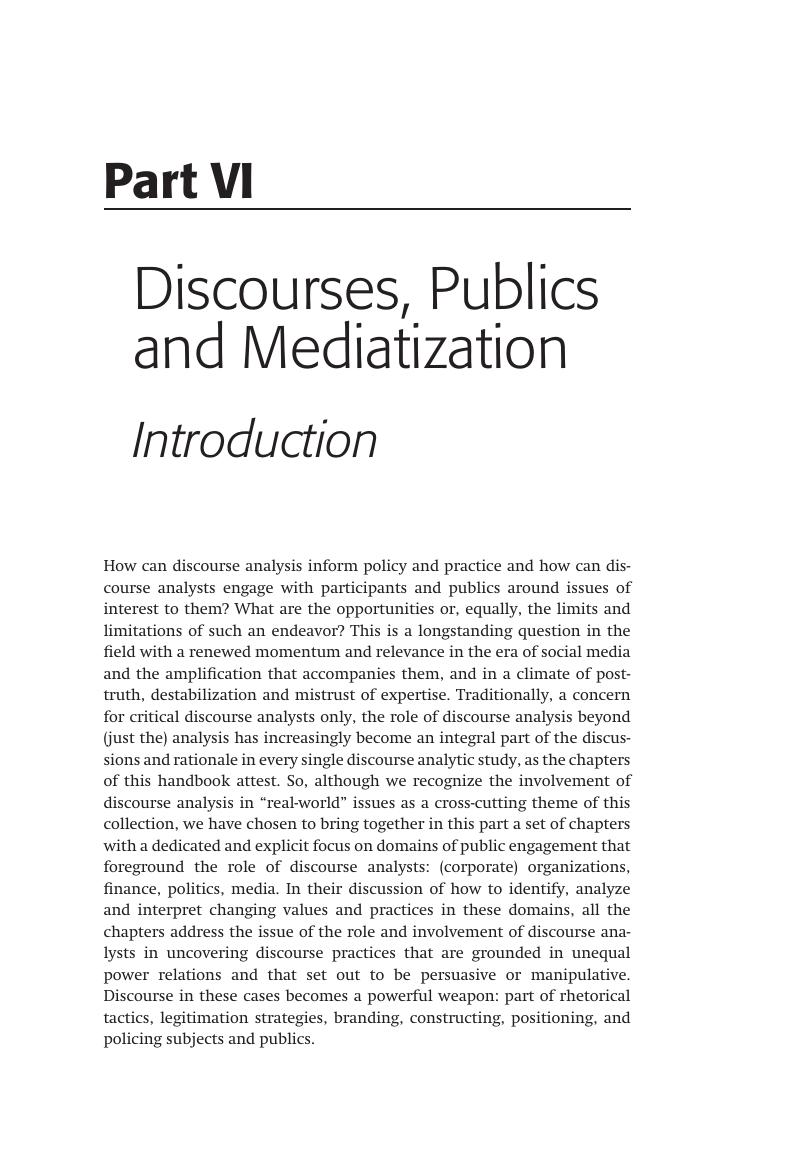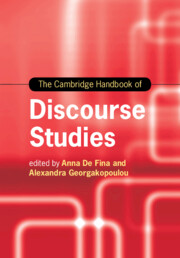Book contents
- The Cambridge Handbook of Discourse Studies
- Cambridge Handbooks in Language and Linguistics
- The Cambridge Handbook of Discourse Studies
- Copyright page
- Contents
- Figures
- Tables
- Contributors
- Preface
- Part I (Con)Textualizing Discourses
- Part II Perspectives and Modes of Analysis
- Part III Discourse Materialities and Embodiment
- Part IV (Trans)Locations and Intersections
- Part V Ethics, Inequality and Inclusion
- Part VI Discourses, Publics and Mediatization
- Index
- References
Part VI - Discourses, Publics and Mediatization
Introduction
Published online by Cambridge University Press: 28 September 2020
- The Cambridge Handbook of Discourse Studies
- Cambridge Handbooks in Language and Linguistics
- The Cambridge Handbook of Discourse Studies
- Copyright page
- Contents
- Figures
- Tables
- Contributors
- Preface
- Part I (Con)Textualizing Discourses
- Part II Perspectives and Modes of Analysis
- Part III Discourse Materialities and Embodiment
- Part IV (Trans)Locations and Intersections
- Part V Ethics, Inequality and Inclusion
- Part VI Discourses, Publics and Mediatization
- Index
- References
Summary

- Type
- Chapter
- Information
- The Cambridge Handbook of Discourse Studies , pp. 593 - 731Publisher: Cambridge University PressPrint publication year: 2020
References
References
Further Reading
In this book, Bhatia introduces, discusses and positions CGA (primarily in relation to CDA).
This edited volume contains a number of genre-oriented studies of political communication, including the analysis of meetings by Wodak (2013) and a chapter by Krzyżanowski (2013) on policy genres in the European Union.
This is one of the more accessible introductions to Fairclough’s uses of genre within his CDA framework.
The volume introduces the New Rhetoric and also contains Miller’s (1984) classic paper “Genre as Social Action.”
This book presents the foundations and a number of applications of Sydney school genre analysis.
The chapter describes how genre is perceived within the discourse-historical approach (DHA).
This chapter gives a good overview of the New Rhetoric, the Sydney school and genre analysis in ESP.
Swales’ book is a key reading regarding genre analysis in ESP.
This introduces van Leeuwen’s multimodal genre analysis.
References
Further Reading
This edited volume’s insightful contributions on the forms and effects of populism across the globe remain relevant to this day.
Moffitt’s book makes a strong case for taking a close look at the performative dimension of populism, in particular the performances of its leaders in relation to crises and the media.
This aptly named introduction manages to give a comprehensive overview of populism across time and space in all its varied forms, providing a concise framework for comparative studies of populism.
This concise work, first published in 2016 and updated a year later, provides an accessible and passionate discussion of contemporary populism, focusing on its inner logic and threat to democracy.
This special issue covers right-wing populism in Europe and the United States and brings together varied approaches from applied linguistics and social sciences.
References
Further Reading
Working with audience responses to an artwork “Capitalism Works for Me!” (by Steve Lambert), Chun analyzes responses to and critiques of people’s understanding of capitalism in their lives.
This book offers an incisive account of neoliberal ideology and its effects on both language and practice in contemporary life. It examines the increasing reach of the “market” and the key figure of the “entrepreneur.” It provides a robust treatment of ideology and how this links to language specifically and linguistics more generally.
This landmark book documents and critically analyzes the effect of market thinking in domains like education, government, religion and self-promotion. The context of each domain is clearly provided while detailed analysis of texts ranges from the lexical through the multimodal to the linguistic landscape.
References
Further Reading
Using a combination of CDA and corpus linguistics, this volume offers comprehensive insights into the ways in which discourse constructs and maintains corporate identity and relationships with internal and external audiences. A wide range of written genres produced by corporations are explored in depth.
This book presents an excellent introduction to the role of language in many facets of business communication including stakeholder communication, brand narratives and management of conflict and self-branding. Each topic is discussed in an engaging way by drawing on a range of authentic examples.
References
Further Reading
Agha’s linguistic-anthropological approach to mediatization emphasizes the importance of commoditized features of communication and their influence in the recontextualization of parts of discourse. It is recommended further reading, especially for a theory of how language/discourse travels across different communication media (cf. Briggs, 2011).
This revised account of the notion of “media logic” underpins (institutional) mediatization research and discusses the discourses of fear as developed and sustained by media logic.
The introduction to this edited volume offers a rich and comprehensive overview of mediatization research, its potential applications and its links with sociolinguistics. The volume overall is an indispensable tool for familiarizing oneself with mediatization research.
This social-constructionist account of mediatization in online discourses on economic affairs proposes the concept of “social mediatization” to account for the ever-growing importance of social media interactions in influencing and shifting modes of participation. It also illuminates the spread and recontextualization of elite terms/discourse in public settings.
The author provides a comprehensive overview of the ways in which technological change in communication has affected newspaper communication and how processes of communication may continue to be changed by technological developments.
References
Further Reading
This is one of the few examples in surveillance studies to seriously engage with theories of discourse analysis, exploring how regimes of surveillance discursively construct social identities and relationships between citizens/customers and the state and corporations.
This chapter gives a comprehensive explanation of the impact of different kinds of media on the discursive processes involved in surveillance.
This article looks at digital surveillance from the point of view of users of digital media, reporting on a research project in which participants described their “folk theories” of how algorithms work and reflected on how these theories affect the way they communicate.

